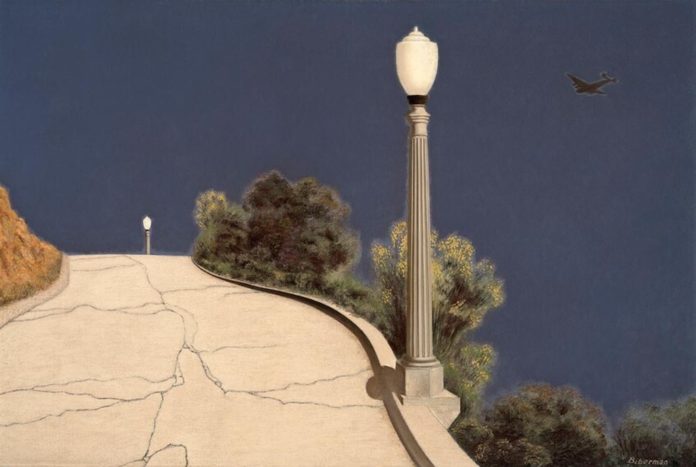
The Huntington Library, Art Museum, and Botanical Gardens will present “Art for the People: WPA-Era Paintings from the Dijkstra Collection,” an exhibition of 19 striking works that will be on view in the Virginia Steele Scott Galleries of American Art from Dec. 2, 2023, through March 4, 2024. Drawn from the collection of Sandra and Bram Dijkstra, “Art for the People” and its accompanying catalog explore representational paintings created in the United States between the 1929 stock market crash and World War II. Organized by the Crocker Art Museum in Sacramento, California; the Oceanside Museum of Art in Oceanside, California; and The Huntington, the exhibition focuses on federal Works Progress Administration (WPA) artists of the 1930s and early 1940s who were employed by the government to help stimulate the post-Depression economy. More than 10,000 artists participated, creating works that represented the nation and its people and seeking to express fundamental human concerns, basic democratic principles, and the plight of the dispossessed.
“Art for the People” highlights paintings from across the United States, with strong representation by California artists, artists of color, women artists, and Jewish artists who have generally been omitted from the WPA-era narrative. The exhibition includes paintings that are often described as American Expressionism or American Scene, depicting both urban and rural subjects and focusing on the lives of average Americans.
“This exhibition will provide visitors with a deeper understanding of both the American past and present,” said Yinshi Lerman-Tan, The Huntington’s Bradford and Christine Mishler Associate Curator of American Art and the exhibition’s venue curator. “Many of the artists featured in ‘Art for the People’ were concerned with the domestic and global threats of the Great Depression, world war, and the looming risk of fascism. These historical and political forces can feel as timely today as they did in the 1930s.”
The exhibition’s installation at The Huntington will feature paintings by 18 artists, including works that were given to The Huntington by the Dijkstras, such as Soldier (1944), a major work by African American artist Charles White. White made the painting after he had been drafted into the U.S. Army. In it, a soldier stands alone in a barren landscape under a turbulent sky. It is a powerful image of an enlisted man—a self-portrait of sorts—experiencing isolation, horror, and existential doubt.

The lives of workers are depicted throughout the exhibition. From Emmanuel Romano’s Construction Workers: Solidarity in Action (1940), which celebrates the contributions of laborers, to Harry Sternberg’s Coal Miner and Family (1938), which confronts the hazards and harsh realities that workers face in mining life. The emotionally stirring composition of Coal Miner and Family presents two scenes at once: In the foreground on the lower left, a sinewy miner focuses intently on what is clearly strenuous physical work. In a poor shanty above him, his family waits, each member thin and pale with eyes sunken or downcast. Sternberg’s painting alludes to a practice he was shocked to discover in the mines surrounding Pittsburgh: Mine owners would sometimes force miners to dig directly underneath the homes in which they lived, potentially causing the homes to sink or even collapse.
Another painting, Miki Hayakawa’s From My Window (1935), adds a poignant serenity to the exhibition. The still life offers an intimate look at the artist’s domestic life and depicts what she saw from a room in her home. In the center of the canvas is a vase filled with bright pink peonies, and a row of succulents are lined up behind it on a windowsill, where just beyond is San Francisco’s Telegraph Hill with Coit Tower at its apex. This view identifies a precise spot on the map, pointing to the movement and displacement of Hayakawa’s life as an immigrant who came to the United States from Japan during the Asian Exclusion period.

The Huntington’s presentation of “Art for the People” is the third and last stop for the traveling exhibition, which originated at the Crocker Art Museum, where it ran from Jan. 29 to May 7, 2023. It will be on view at the Oceanside Museum of Art from June 24 to Nov. 5, 2023. The show is presented differently at each of the venues.
“Art for the People” is accompanied by a fully illustrated hardcover catalog with essays by art historians Susan M. Anderson, Henry Adams, and Scott A. Shields.
This exhibition is supported by the Hannah and Russel Kully Fund for American Art and the Susan and Stephen Chandler Exhibition Endowment.

About The Huntington
The Huntington Library, Art Museum, and Botanical Gardens is a cultural and educational institution of global significance. Building on Henry E. and Arabella Huntington’s renowned collections, The Huntington supports research and promotes education in the arts, humanities, and botanical science through the growth and preservation of its collections; the development of a community of scholars, school programs, and partnerships; and the display and interpretation of its extraordinary resources for diverse audiences. The Huntington is located at 1151 Oxford Road, San Marino, California, 12 miles from downtown Los Angeles. Visitor information: huntington.org.



















